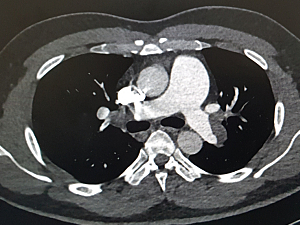The Pulmonary Embolism Thrombolysis (PEITHO) trial, published in 2014, compared full-dose systemic fibrinolytic therapy with anticoagulation monotherapy in patients with intermediate- high–risk pulmonary embolism (PE). The incidence of clinical deterioration was lower with fibrinolytic therapy, but more bleeding events counterbalanced that benefit.
Catheter-directed thrombolysis (CDT) may optimize fibrinolytic drug delivery into the pulmonary arteries, allowing dose reduction and resulting in fewer bleeding events. CDT has demonstrated some beneficial short-term effects in observational studies and small clinical trials.
Now, Behnood Bikdeli, MD, MS, clinician–investigator in the Division of Cardiovascular Medicine and Thrombosis Research Group at Brigham and Women’s Hospital, and colleagues have reported favorable longer-term results of CDT. In a randomized clinical trial published in JAMA Cardiology, they observed a more durable effect of CDT plus anticoagulation than with anticoagulation monotherapy on several three-month metrics.
Methods
The team conducted CANARY, an open-label, masked–end point trial performed in two large cardiovascular centers in Tehran, Iran. Adults were eligible if they presented within 14 days from symptom onset with acute intermediate-high–risk PE confirmed by CT pulmonary angiography and a score ≥1 on the simplified Pulmonary Embolism Severity Index.
Between December 22, 2018, and February 2, 2020, 94 participants (mean age, 58 years; 29% female) were randomized 1:1 to:
- Anticoagulation monotherapy—Twice-daily subcutaneous enoxaparin (1 mg/kg) for the first 48 hours of enrollment, followed by oral anticoagulation
- CDT plus anticoagulation—One infusion catheter per involved pulmonary artery; fixed-dose alteplase (12 mg for unilateral and 24 mg for bilateral involvement) was administered along with 500 units/hour of unfractionated heparin (UFH). After removal of the catheter(s), UFH was increased to therapeutic levels. In eligible patients, UFH was changed to enoxaparin as administered in the control group
Transthoracic echocardiographic examinations were planned for admission, 72 hours after randomization and the three-month follow-up visit. The study was prematurely stopped due to the COVID-19 pandemic, and only 85 patients completed the three-month follow-up.
Primary Efficacy Outcome
The primary outcome, the proportion of patients with a right ventricle/left ventricle ratio >0.9 at the three-month follow-up, did not differ significantly between treatment arms (4.3% for CDT vs. 12.8% for anticoagulation monotherapy; OR, 0.31; P=0.24).
Secondary Efficacy Outcomes
Secondary outcomes, analyzed in all participants, favored CDT:
- The proportion of patients with RV/LV ratio >0.9 at 72 hours after randomization—27% with CDT vs. 52% with anticoagulation monotherapy (OR, 0.34; P=0.01)
- The proportion of patients with unrecovered RV function at three months—6.2% vs. 28.2% (OR, 0.18; P=0.009), respectively
- All-cause mortality rate at three months—Three patients died during the three-month follow-up period, all in the anticoagulation monotherapy group; two of the deaths were adjudicated as PE-related
Safety Outcomes
Adverse events in the CDT group were:
- One case of spontaneous intramural esophageal hematoma was noted during the final hour of fibrinolytic infusion and managed conservatively
- One case of major bleeding (nonfatal gastrointestinal bleeding, Bleeding Academic Research Consortium type 3a)
- Three cases of minor bleeding (vascular access-site hematoma, BARC type 2)
No severe thrombocytopenia or fatal or intracranial bleeding occurred in either group.
Commentary
This trial was underpowered to detect a statistically significant difference between CDT and anticoagulation monotherapy concerning the primary outcome. However, the improvement in secondary outcomes and low risk of major bleeding in the CDT group are hypothesis-generating and may inform the execution of a definitive outcomes trial.
